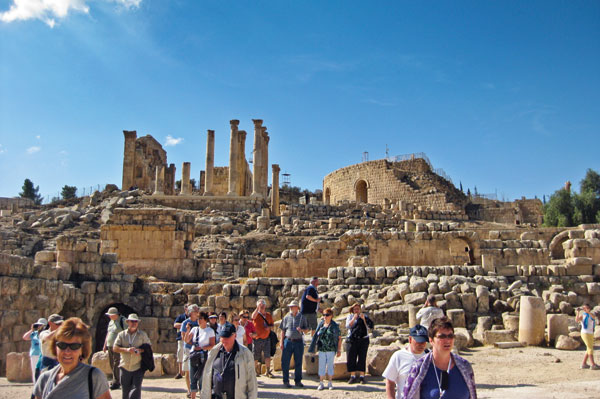 For Christians, visiting the Holy Land provides the opportunity to experience the biblical narratives through a new perspective. We walk where Jesus walked. We visit where he was born, the places where he preached and the traditional sites of his Crucifixion and Resurrection.
For Christians, visiting the Holy Land provides the opportunity to experience the biblical narratives through a new perspective. We walk where Jesus walked. We visit where he was born, the places where he preached and the traditional sites of his Crucifixion and Resurrection.
In October 2011, 42 Salvation Army officers visited the Holy Land. This was the second year that The Salvation Army in Canada and Bermuda sent a delegation.
“These pilgrimages promote the spiritual enrichment of our officers,” says Major Mona Moore, leadership development secretary. “They also foster the increase of biblical knowledge and awareness of Scripture, which heightens teaching and preaching ministries.”
Here are reflections from five of the officers who visited the Holy Land.
Bethlehem: Where God Came Down
by Captain Donna Simms
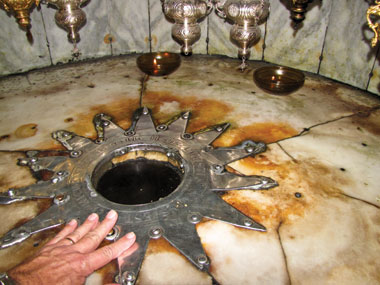
As we entered Bethlehem, I was reminded of the Christmas carol, “O little town of Bethlehem how still we see thee lie.” Today's Bethlehem, however, isn't little or still, but rather a bustling city. As we navigated the streets, I tried frantically to push aside the distractions and concentrate on the significance of this special place. Then we arrived at the Church of the Nativity, a site that has survived many hostile invasions as it seeks to preserve this sacred spot where Jesus was born.
As I stood in line and waited for my turn to enter, I was at first disappointed by the crowd and the formality of the experience. But then I remembered that God does so many amazing things, many of them difficult for me to understand.

In that moment, the fact that “The Word became flesh and blood, and moved into the neighbourhood” confounded me (see John 1:14 The Message). God as a baby. A helpless baby. Yet this is how and where he chose to enter the world. He could have chosen the miraculous and regal, but instead chose a stable and a peasant family. This was all part of God's plan: “We saw the glory with our own eyes, the one-of-a-kind glory, like Father, like Son, generous inside and out, true from start to finish” (John 1:14 The Message).
The stable didn't look like a stable, but in that brief moment I knelt to honour this place where God and humanity met. The truth of his divine and sacrificial love overwhelmed me. What a blessed location this truly was, not because we came to visit, but because this was where God came down.
“But you, Bethlehem Ephrathah, though you are small among the clans of Judah, out of you will come for me one who will be ruler over Israel, whose origins are from of old, from ancient times” (Micah 5:2).

Galilee: Walking Among the People
by Major Don Grad
As we explored the Sea of Galilee, it was amazing to witness the contrasts found in such a small geographic area. There are modern cities, such as Tiberias, complete with luxury cars and four-star hotels, and yet nearby there are Bedouin camps made from tin, plastic and canvas with goats and camels outside. The Bedouin choose to live simply, so as to be unencumbered by the material things of life.

The land is a mixture of valley rifts and mountain ridges. The mountains are very dry, and the valleys are fertile and green. North of the Sea of Galilee, where the headwaters of the Jordan River are located, the land is lush. Mount Hermon is covered with snow most of the year and provides much of the water for the Jordan River, which then flows into the Sea of Galilee and on to the Dead Sea.
This land that God gave to his people is truly beautiful and bountiful. It was interesting to contemplate how Jesus would have traversed the land multiple times using foot power instead of an air-conditioned bus, as our group did. The landscape can be very rocky, and it was a kind gesture for Joseph to have had a donkey for his pregnant wife, Mary, to ride on as they journeyed to Bethlehem.
The many mountain heights provide amazing views of the land, and it was easy to imagine Jesus standing on any number of hills, waiting as the crowds gathered to hear him. Geopolitics is never far from mind in this area, and rockets were launched into Israel from the Gaza Strip during our visit. My prayers would often focus on asking God for peace for Israel and Jerusalem, and that people would see the true Prince of Peace.
As we visited locations such as the Mount of Beatitudes, Nazareth, Mount Arbel or travelled on a boat in the Sea of Galilee, I gained a fresh perspective on the stories we read in the pages of the Old and New Testaments. Our tour guide provided many fascinating history lessons of the land and its people. Seeing the topography of the land brought the Bible stories to life. For example, we learned how winds can come suddenly out of the Jordan valley from the north, which then turn the Sea of Galilee into a churning rage with very high waves.
Throughout our journey, I reflected on the image of Jesus walking the land, telling the story of God's love and his plan for those who will follow him. Just as the land is full of contrasts, Jesus spoke to a great contrast of people with his wonderful gospel message that is for the whosoever.
The Garden of Gethsemane: Experiencing Anguish
by Major Donna Anstey

During my pilgrimage to the Holy Land, I had a number of moments that stopped me in my tracks. One of these was in the Garden of Gethsemane. As we entered this holy place, time seemed to stop. We were the only group there, which afforded us some private moments not experienced by most pilgrims.
Surrounded by olive trees—just as when Jesus and his disciples were there—we walked in quietness, each of us with our own thoughts and a sense of our own unworthiness. Feeling humbled and weeping with emotion, I prayed and meditated on what had happened here around 2,000 years ago.
We gathered in a small, secluded spot and shared in group devotions. We listened as God's Word was read, hearing once more the heartrending story of Jesus facing this experience alone, surrounded by his sleeping disciples. The question came to my heart, How often am I so taken up in my own need that I am not available when Jesus needs me? And so I prayed, Loving Father, keep me awake to your voice.
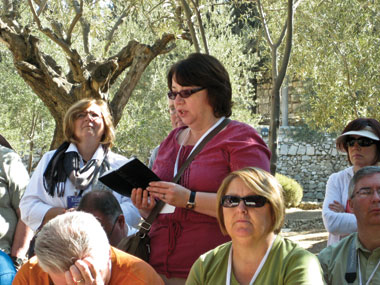
During our meditation, we reflected on how an angel came to strengthen Jesus, how Judas betrayed Jesus with a kiss and how Jesus restored the ear of one who came to harm him. And then, in a moment that will never be far from my thoughts, Major Beverly Ivany sang the beautiful song, I Walked Today Where Jesus Walked. As she came to the final verse and sang about the Garden and climbing the hill of Calvary where our Saviour died, her voice broke, and my heart was strangely warmed, as we truly met Jesus in those moments and felt him close to us.

Via Dolorosa: The Path That Jesus Trod
by Major Karen Feltham
I feel as if Jesus is beside me as I step away from what may have been his prison cave while he awaited his Crucifixion. The smell of the musty prison lingers in my nostrils as my eyes adjust to the brightness of the morning sun. I am awestruck and full of wonder as my feet make contact with the Via Dolorosa, Christianity's most holy route. This is the path that Jesus trod as he made his way to Golgotha.
The street ahead is busy and crowded as people carry on the business of the day. People are pushing and shoving for posi-tion. I make my way through the crowd that is oblivious to my presence, except for the shop owners who want me to buy their wares.
In this moment, it is no longer 2011. I picture the crowd as Jesus would have seen them on his divine walk down the Via Dolorosa. What must he have thought of these masses?
It is nothing to me that no one notices the significance of this walk of mine, yet I am grieved in my heart to realize that as Jesus carried his cross down this very road, many paid no attention to him. They did not realize that the Saviour was walking before them as they continued with the business of their day, unaware of the sacrificial love being spilled out. And I am grieved with the knowledge that many who did notice Jesus chose to mock him.

As I walk along the path and try to see through Jesus' eyes, I hear an echo in my heart. I sense that as Jesus viewed the clamouring crowds around him, there was a prayer in his heart. I believe that before Jesus voiced the prayer “Father forgive them” on the cross, the words had resonated over and over again in his heart as he passed his accusers, mockers and even the apathetic along the way.
As I pass the place where he fell beneath the weight of the cross, the scoffers' noise becomes all the louder, yet in his heart I hear the whispered, “Father, forgive them.”
Then before me is Golgotha, the hill of Calvary. I pause as the Via Dolorosa comes to an end. The whispered words of forgiveness will soon become an echo not only through the corridors of these streets but through all eternity.
But then I return to the present. I am challenged within my own heart to pray as Jesus did, “Father, forgive them.” I am called to enable others to see the significance of Jesus' journey along this path. I am commissioned to go and tell others that forgiveness still comes from our loving Saviour, who walked the Via Dolorosa before me.
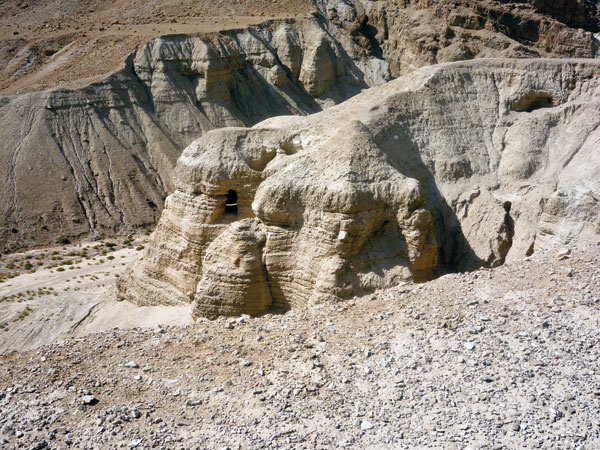
Qumran: The Dead Sea Scrolls
by Major Glenn Patey
While travelling along the north-east shore of the Dead Sea, our tour guide pointed out some caves in the distance. “That's Qumran,” she said, “where they found the scrolls.”
To be honest, it didn't look like much. All I could see were three or four caves set in the side of a desolate barren hill. If it hadn't been for the very limited knowledge I already had, I would not have thought too much about this site. Besides, we had already toured the Shrine of the Book in Jerusalem, which housed hundreds of shards, fragments and writings from Qumran. What else was there to see, except the caves themselves?

Once we arrived, however, I was immediately captivated by a stone inscription that told how Bedouin shepherds had found the Dead Sea Scrolls stored in jars inside these caves.
It was as if I had suddenly become a time traveller. The walls of these caves had held the collective work of perhaps hundreds of committed God-believers who laboriously penned and re-penned much of the Hebrew Bible more than 2,000 years ago. To make their labour all the more arduous, the scrolls were etched in bad lighting conditions. Inkwells and writing utensils discovered through the years were crude at best.
The only complete Book of the Old Testament that was found is known as the “The Great Isaiah Scroll.” This scroll was located intact in the initial Bedouin discovery in 1948. When I got a glimpse of the Great Isaiah Scroll on the wall before me, I was thankful to the ancient scribes for being so meticulously dedicated not just to their craft but to their calling. With my limited Hebrew, I scanned the scroll, mostly pretending that I could read such verses as, “A shoot shall come up from the stump of Jesse,” “Comfort, comfort my people,” and “He was oppressed and afflicted, yet he did not open his mouth.” As my time travel ended that day, I prayed that I would become as concerned and tender about God's Word in reading it, preaching it, teaching it and living it as those God-followers of 2,000 years ago who etched the Scriptures in leather with sharpened reeds.







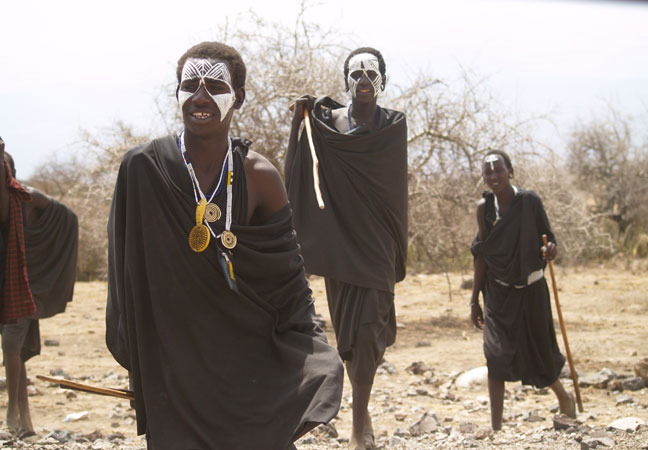


Comment
On Saturday, January 21, 2012, emily hicks said:
On Friday, January 20, 2012, Sharon Hale said:
We are so grateful officers are now having that experience...their proclamation of the Word will be so enhanced.
Leave a Comment